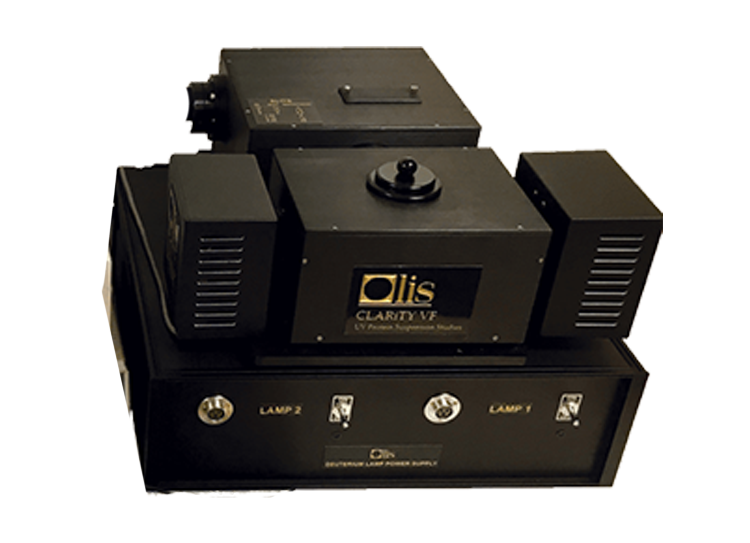Post-dispersive versus Pre-dispersive
Ensuring you appreciate that they are different. With consequences.
Broadband (diode array & CCD) versus monochromatic measurement light (all scanning spectrometers)
Light path through single grating monochromator
Post-dispersive spectrometers include diode arrays and CCD spectrometers. These modern devices are solid-state, fast, and modestly inexpensive. We enthusiastically support one diode array spectrometer - the HP 8453 series – and one CCD, and the Avantes CCD.
However, the limitations of these instruments are real, with bleaching or overheating of photolabile samples (as illustrated above) one of the most obvious.
The designers of post-dispersive spectrometers achieve the best performance by using an “array” of diodes and:
very bright broadband light sources
single grating spectrographs (higher efficiency and higher stray light than double grating monochromators)
large entrance slits (relatively poor optical resolution) and
long integration times (as the photodiode array sums up the light incident on it over time) which lead to ‘smearing’ of the spectral information over time.
The result is a fast, low cost device, but with lower photometric accuracy than a scanning spectrometer.
Further, the sample is very near the broad-band or white light. For photolabile samples, this is a death sentence! Be aware of the potentially ruinous photolyzation which occurs during the measurement, especially over long acquisition periods.
And notice how far the detectors are far from the sample. There is literally a spectrograph or post-dispersive element between sample and detector. This distancing of sample and detector is one of the reasons why turbid samples cannot be examined with diode array spectrometers.
These inherent design conditions contribute to “noise” (error) in the photometric data which can be very hard to remove; in fact, it is difficult to know for sure whether it is even an issue, since it is inherent in the instrumentation.
Thus, while the diode array might provide clean looking spectra (depending upon collection conditions), there is the real likelihood of photometric error.
Conclusion: Diode array systems are absolutely great for some cases. They are not the spectrophotometers of choice when (1) one wants the best possible time resolved spectra, (2) one is working with photosensitive systems, (3) one is working with turbid samples.
.
Light path through double grating monochromator
The cartoon now shows the ‘pre-dispersive’ spectrometer, where the measurement light is dispersed into gentle monochromatic light. All OLIS and Cary-based spectrophotometers are of this type.
Very bright broadband light sources
Double monochromator for highest efficiency and highest stray light rejection*
Adjustable slits to obtain very high spectral resolution (down to 0.1 nm on many).
Exquisitely sensitive detectors for UV/Vis (PMT) and NIR (PbS or InGaAs).
*All the OLIS products identified with “1000” in the name employ our patented and award-winning “subtractive double grating monochromator with moving intermediate slit” [hyperlink to patent]. These double monochromators support millisecond spectral scanning rates, topping the diode array by 10 fold. They also provide milli-absorbance sensitivity, extreme photometric precision, and gentle monochromator measurement light. Since the models 1000 spend 0.001 seconds to measure the entire spectrum, some noise in each scan is inevitable. However, this is a “good” noise, i.e., random ‘shot noise’ from the PMTs which has minimal effect on the quality of the kinetic and spectral fitting results. (And, a scan is a 2D data point, of which there are 1000 collected per second!)
Sensitivity to the fourth or fifth decimal place is achievable, in seconds, given sufficient signal. Very high photometric accuracy is assured with photomultiplier tubes as the detectors.
The double monochromator in all OLIS products identified with “14,” “17,” and “172” use the prism+grating monochromator produced by Cary Instruments during the era when no compromises were allowed. Subnanometer spectral resolution, extreme photometric precision, and gentle monochromator measurement light are standard on these superb models.
Every OLIS spectrophotometry built from scratch here in Athens, Georgia, employs a scanning monochromator and highest sensitivity detector.
The diode array and CCD systems in our product line are produced by others and upcycled by us.
Both product types have their place. We encourage you to know why you are choosing one or the other.
“One of the reviewers said there is no way that you can do optical stopped-flow studies with a B12 compound, yet there it is, because unlike a diode array, you are not blasting the hell out of the sample with white light in the RSM.”Prof George ReedUniversity of Wisconsin
DIODE ARRAY & CCD MODELS:
(Post-dispersive)
SCANNING MODELS:
(Pre-dispersive)






